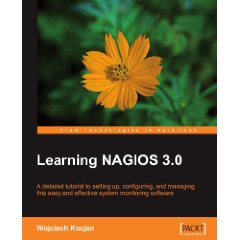
I received a copy of Learning Nagios 3.0 for review. The book was written by Wojciech Kocjan. As I’m a Nagios users for years now (started around 2000 if I’m right), I was interested in learning more about the new 3.0 features.
IMHO, Nagios is one of the most powerful open source monitoring platform ever! But often “power” also means increased “complexity” and the maintenance of a Nagios configuration with thousands of hosts and services to monitor can quickly become a real nightmare!
Even if Nagios is a complete stand-alone solution, today, it has been successfully integrated into several monitoring and reporting suites like Groundwork or OSSIM. Other add-ons greatly simplified the management tasks (using web interfaces). Anyway, it’s always good to go back to the basics and learn how the product is working.
The book successfully addresses both audiences: the Nagios newbies and the advanced administrators. However, for the newbies, a good UNIX knowledge is highly required. The author describes the installation of a Nagios server from scratch (starting with the compilation). This is indeed the best way to learn!
Chapter one covers the benefits of a good monitoring tool for companies. Major Nagios concepts are quickly presented and the new features of Nagios 3.0 are reviewed. [The most interesting part for me]
In chapters two and three, the author covers a step by step installation and the configuration of the key elements: hosts, services, contacts, time periods and notifications. Then the user(web) interface is analyzed. Chapter four covers the Nagios plugins and basic checks that can be performed.
Starting from the next chapter, things will become much more interesting and cover a lot of “hot” topics: advanced configuration (chapter five), notifications and events (chapter six), passive checks (chapter seven), remote hosts monitoring (chapter height), SNMP (chapter nine), advanced monitoring – like Windows hosts (chapter ten). Finally, the last chapter will give some nice ways to extend your Nagios.
In all chapters, the new features of Nagios 3.0 are described (what’s new, what changed, etc). The author gives also nice tips to manage complex environment (the organization of config files on disk, how to notify in a efficient way, …)
The book is a must read for all system or network administrators who are involved in Nagios projets. It can help them to have a good overview of the Nagios features and avoid classic mistakes when a monitoring project is started inside an organization (which often lead to a total loss of credibility in the product). Even if you already experience with Nagios, read the book, it will at least give you some nice idea to better manage your environment!
I have also made a review of this book and I liked it:
http://www.it-slav.net/blogs/2009/05/13/review-learning-nagios-30/
mel61,
First, as I approved your comment, I would like to show that no censorship is made on this blog (except if comments become politically incorrect). Feedback is always welcome. Thanks!
Regarding the book now, first I don’t have any relation with the author and I was not paid for the review! According to your comment, you should have a very strong Nagios knowledge. If you monitor thousands of devices worldwide, you are using distributed monitoring for sure. This is not the easiest part of a Nagios configuration. I don’t think that the book focuses on an audiance of so experimented admins like you. The author explains how to install a Nagios server from scratch but does not examine the source code, indeed! One more time, if you feel confortable to read the inside of Nagios, do it. There will always be better books which will meet your expectations. I think if was not the case with this one.
The book is not the only one which covers Nagios. Thanks to mention another one.
Regards,
Xavier
This book is a WASTE of money. $40 for less than what you get in the online doc and apparently written by someone who has very little experience with Nagios and probably little experience with administering Linux/Unix systems. I have managed monitoring systems for almost 10 years and Nagios for about 5. Our network consists of thousands of nodes in multiple locations. This book helps very little and not worth the price. It was definitely not worth the time reading it. The Wolfgang Barth book three times the size, covers more details, easier to understand and was written by someone who looked through the source code to see how Nagios behaves and it not just rephrasing things out of the other Nagios doc.
Anyone who says this is a “must read” has not seen any other Nagios book. is a personal friend of the author, or was paid to write a “review”.
Do yourself a favor and get FAR more useful information and buy the Barth book.